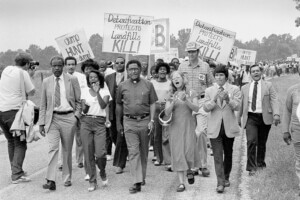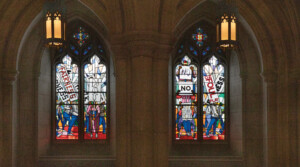One hundred and ten years ago, W.E.B. Du Bois published “Reconstruction and its Benefits” in The American Historical Review. In the essay, Du Bois questioned the then-prevailing Dunning School narrative that described the Reconstruction era as an aberration in civic history that harmed the country. Instead, Du Bois argued, the time was marked by the successful efforts of Black citizens to use their recently hard-won political agency to progress democracy and improve the quality of life for all Americans by doing things like instituting free public schools and enacting new social legislation. That the period came to an end was arguably the result of white economic interests subjugating collective social and democratic ones, not because of any intrinsic ineptitude of Black representatives in governance.
Du Bois’s writings form the backdrop of an upcoming exhibition at the Museum of Modern Art (MoMA): Reconstructions: Architecture and Blackness in America. It will be the fourth installment in the museum’s Issues in Contemporary Architecture series and will take place from February 20 through May 31, 2021. The exhibition was curated by Sean Anderson, associate curator at MoMA; Arièle Dionne-Krosnick, curatorial assistant at MoMA, and Mabel O. Wilson, professor at Columbia University and co-editor of the recently published Race and Modern Architecture.
“Our exhibition, more than two years in the making, began as a question about how we can repair ourselves and our histories while observing the histories of architecture and urbanism in the United States,” said Anderson. “[It has] since evolved into 11 important conversations with architects, artists, and designers, each of whom has established new forms and methods elevating who and what makes architecture today. Their individual meditations, embedded within newly commissioned projects, observe the spatial evolution of American cities while speaking to the past, present, and future as intersectional narratives. Working across drawing, models, films, video, and installation, the projects seek to un-build those systems that contain and imperil BIPOC communities.”

A field guide accompanying the MoMA exhibition that will include the ten exhibited projects and a commissioned photographic essay by David Hartt, Anderson noted, will not be “a catalog in the conventional sense but a resource that is accessible to many, simultaneously acknowledging the legacies of anti-Black racism as a basis for the design and building of American cities but also amplifying the voices, images, and spaces of a just architecture.”
The Black Reconstruction Collective (BRC) is composed of Emanuel Admassu, Germane Barnes, Sekou Cooke, J. Yolande Daniels, Felecia Davis, Mario Gooden, Walter Hood, Olalekan Jeyifous, V. Mitch McEwen, and Amanda Williams. Upon being invited to contribute to the exhibition at MoMA, the Black architects, designers, and artists formed the BRC as a 501c3, Daniels said, “in response to the exhibition and to the current crises in America.” According to its mission statement, the BRC “provides funding, design, and intellectual support to the ongoing and incomplete project of emancipation for the African Diaspora,” and is “committed to multi-scalar and multi-disciplinary work dedicated to dismantling systemic white supremacy and hegemonic whiteness within art, design, and academia.” All ten members of the BRC have a background in architecture, but their varied experiences across academia and practice bring a kaleidoscopic lens to their work.
Part of the BRC’s ongoing effort includes a three-part public virtual discussion series to address three critical questions about the role of Black Reconstruction in spatial practice. The first event, framed around the question “What is the architecture of reparations?” was hosted by the Columbia Graduate School of Architecture, Planning and Preservation and the school’s Black Student Alliance on October 5. The upcoming second event, to be held on November 17 and hosted by Harvard Graduate School of Design (GSD), GSD African American Student Union, and AfricaGSD, brings Du Bois’s reframing of the role of Black agency in the Reconstruction era to the challenges of our present times, asking “What does it mean to imagine Black Reconstruction today?” In December, the BRC will hold the third event, hosted by MIT, taking on the theme of “What is the architecture of Black futures?”
Du Bois’s observations on the positive outcomes of the enfranchisement of the Black worker in the 19th century are echoed in the 21st century calls for political action embodied by the Black Lives Matter movement. They are also increasingly relevant to achieving social justice within architecture and urbanism. In a profession where Black voices make up less than two percent of all architects and the majority of urban Black Americans have little access to architectural expertise while being increasingly subject to the adverse effects of gentrification, progress can only be achieved by supporting diverse participants in actively contributing to shaping the built environment—whether as architects, citizens, or both. Working across media and facilitating much needed discourse, the BRC is poised to do just that.











